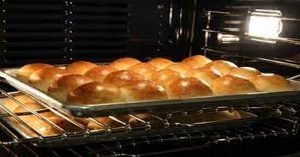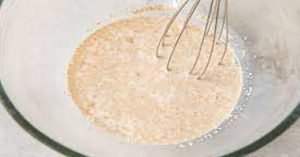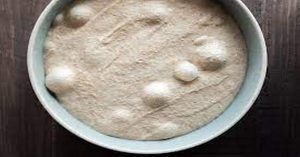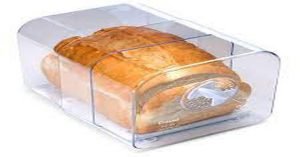Watch All the Temperatures

Table of Contents
Watch All the Temperatures – FUNDAMENTAL FACTS – PART I
USE COOL WATER TO SOFTEN YEASTS
Correct temperatures are so important for good bread-making. The first one to watch is that of the water in which the softened yeast.
The best temperature for this water is between 85° and 90°F if you are using compressed yeast. A higher temperature may kill many of the yeast cells before they ever get into the dough. If you have no thermometer, test the water on the inner side of your wrist. Water at 90°F will feel cool.
When you use active dry yeast, the water for softening the yeast may be as high as 110°F without damage to the yeast. This will feel slightly warm on your wrist.
COOL THE LIQUID BEFORE ADDING THE
SOFTENED YEAST
The next temperature to watch is that of the liquid and flour mixture when the softened yeast is added to the dough.
Add the yeast when the mixture is between 85° and 90°F. Here is a good guide to help you find the best temperature for milk used in mixing the dough. The flour will be about the temperature of the place where it is kept.

This temperature and that of the room will determine what temperature you will want the liquid, to insure the finished dough of 85° to 90°F when you put it to rise
In the winter, if the room is cool and the flour is cold, you will need warmer liquid. In summer when the room and the flour both may be very warm, you will want cooler liquid.
Assume that the room temperature is 80°F and that of the flour is 80°F and the liquid is 80°F. Those figures total 240. Here are examples:

You will find in the recipe section, that the directions call for part of the flour to be added before the softened yeast goes into the dough mixture.
The cool flour will lower the temperature of the liquid, while the hot liquid warms up the cool flour.
Then you can add the yeast, which you previously softened in the lukewarm water, without the danger of killing some of the yeast cells from too high a temperature when you mix the dough.
This is very important in cold weather when the liquid may need to be above 85° or 90°F to make a finished dough at the right temperature.
KEEP THE FERMENTING DOUGH AT 85°F
The third important temperature is during the entire fermentation process. The yeast action is best during the rising period when the fermenting dough is kept between 85° and 90°F.
If necessary put the bowl or crock into a pan of warm (not hot) water. Change the water as needed to keep this temperature constant.

BAKE THE BREAD AT 450°F
Correct baking temperature is most necessary for high-quality bread. When the bread is ready to bake, put it into an oven that has been preheated to 450° F.
This temperature sets the cell walls quickly and stops further rising. In Utah’s high altitudes and dry climates, bread baked at 450°F for 35 to 40 or 45 minutes will be better than if it is baked at a lower temperature for a longer time.
The baking time varies with the altitude. The higher the altitude the longer will be the baking time.
If you find your bread getting too brown when the oven registers 450°F you probably have an inaccurate register. Check your oven with a good oven thermometer. Have your gas or power company check your oven thermostat.
Keep the oven at 450°F for the entire baking period unless your particular oven does too much browning. If you have to turn it down to 400° or 425°F do this after it has baked at 450°F for 15 or 20 minutes. This high temperature at the beginning will stop the yeast action and set the cell walls.
Much bread which has been handled properly at every stage up to baking fails to reach a high standard because it goes into an oven that is not hot enough. Bread baked from dough that got too light will have a coarse, overly porous texture and a thick coarse crust.
Bread baked in an oven where the temperature is uneven may develop a large crack on one side of the loaf. We call this a shell crack. This shell crack comes from imperfect circulation in the oven.
The uneven heat may be due to a faulty oven. It may come from crowding too many loaves into the oven so the hot air cannot circulate evenly around each loaf. The shell crack comes on the coolest side of the loaf.
A shell top is another bread fault that may come from dough that gets too light before the oven heat sets the cell walls. A slight jar will cause the dough to fall.

This may come before or after the loaf of dough goes into the oven. The baked loaf may look all right from the outside. When you cut into it, you find a large hole immediately under the crust.
This hole was left by the collapsing dough. The shell top may come when you leave a large gas bubble under the top of the loaf.
If the dough gets a dry surface while it is rising, the shell top is more apt to develop. Keep a damp cloth over the loaves after you put them into the pans.
Baked bread at too low a temperature will get too light before the cell walls are hardened. The cell walls stretch too far and then they collapse. This leaves some of the dough hanging over on each side of the
pan. This we call an over-hang.
BAKING TEMPERATURE FOR FANCY ROLLS IN UTAH
IS 375°F instead of 450°F which we use for plain bread. Fancy bread has more sugar. The extra sugar makes them brown too fast at a higher temperature.

STORE THE BREAD IN A COOL PLACE
The last temperature to watch is after the Watch All the Temperatures – FUNDAMENTAL FACTS – PART I is cooled. Turn the bread out of the baking pans onto wire racks to cool. Cool it completely before it is wrapped and stored. Keep it out of drafts while it is cooling. Keep bread in a cool storage place until it is used.
